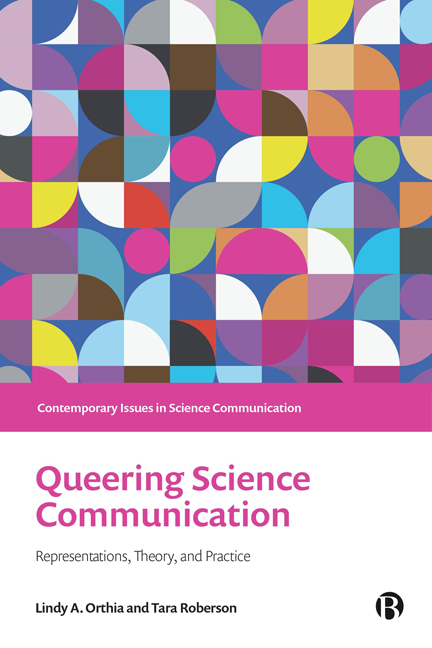Book contents
- Frontmatter
- Contents
- Series Editor Preface
- Notes on Contributors
- Acknowledgements
- Terminology and Sensitive Content in This Book
- Introduction
- PART I Negotiating Queer Identities with Science, Technology, and Medicine
- PART II Representations of Queerness in Public Science Communication
- PART III Queer People in Science Communication Communities
- PART IV Queering Institutional Science Communication Agendas
- Conclusions
- Index
10 - The Possibilities of Queer in Science Communication Teaching and Pedagogies
Published online by Cambridge University Press: 18 January 2024
- Frontmatter
- Contents
- Series Editor Preface
- Notes on Contributors
- Acknowledgements
- Terminology and Sensitive Content in This Book
- Introduction
- PART I Negotiating Queer Identities with Science, Technology, and Medicine
- PART II Representations of Queerness in Public Science Communication
- PART III Queer People in Science Communication Communities
- PART IV Queering Institutional Science Communication Agendas
- Conclusions
- Index
Summary
Pedagogy in science communication can be wide ranging, spanning formal education, informal education, everyday science learning, and professional development contexts. This chapter considers how we might apply the concept of queer pedagogy to these multiple processes and settings. To paraphrase Luhmann (1998), what would a queer pedagogy of science communication (QSCP) look like? What would be its ambitions, and where would it take place? Is QSCP something just for queer science communicators and students? Or would the practice also include queering the science communication curriculum? Or is it about queer learning, teaching, and practices within the broad umbrella of science communication? In this chapter we approach all these questions and explore what queer theory might bring to science communication and the possibilities of teaching it queerly.
Radical pedagogies (hooks, 2003; Freire, 2018; Giroux, 2020) and queer theories have served as forms of critical or subversive interventions in both oppressive classroom relations and social architectures of heteronormative sexualities and genders for a long time now. Pedagogy is often understood as referring to the ‘how-to’ of teaching. Yet more recently, as Luhmann notes, ‘flagged by signifiers such as feminist, radical, and anti-racist,’ pedagogy is now ‘highly critical of mainstream education and of its tendency to reproduce racial, gendered, and class-based power relations in its institutions, ideologies, and practices’ (Luhmann, 1998 p 125, italics in the original). Common to these radical pedagogical approaches is the desire to intervene in the reproduction of power dynamics and to create more inclusive learning environments through the transformation of curricula and the structures of social interactions within classrooms. In using queer here we draw on the distinctions made by Morris (1998) between the use of queer as a subject position and queer as a politic, which do not always necessarily overlap. While queer theory emerged from the study of, and viewpoints of, people who are considered outsiders in terms of sexual and gender identities, it has also been used to interrogate all claims of ‘normalcy’ and the processes by which these are defined and policed (Greene, 1996; Morris, 1998; Shlasko, 2005). If, as Britzman (1995) suggests, queer pedagogy's goal is the radical practice of deconstructing normalcy, then as Luhmann (1998) argues, ‘it is obviously not confined to teaching as, for, or about queer subject(s)’ (p 129).
- Type
- Chapter
- Information
- Queering Science CommunicationRepresentations, Theory, and Practice, pp. 181 - 190Publisher: Bristol University PressPrint publication year: 2023



